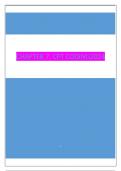CHAPTER 7: CPT CODING2024
a
,CHAPTER 7: CPT CODING QUESTIONS AND
ANSWERS
;A semicolon - answer-is used to save space in CPT, and some code descriptions
are not printed in their entirety next to a code number. Instead, the entry is
indented and the coder must refer back to the common portion of the code
description that is located before the semicolon. The common portion begins
with a capital letter, and the abbreviated (or subordinate) descriptions are
indented and begin with lowercase letters.
(1) identifying the place of service (POS) and/or type of service (TOS) provided to
the patient,
(2) determining whether the patient is new or established,
(3) reviewing the patient's record for documentation of level of service
components,
(4) applying CMS's Documentation Guidelines for Evaluation and Management
Services, and
(5) determining whether E/M guidelines (e.g., unlisted service) apply - answer-
Accurate assignment of E/M codes depends on:
*Care coordination (when not separately reported with another E/M code)
*Communicating results of ancillary tests to the patient, family, or caregiver
*Counseling and educating the patient, family, or caregiver
*Documenting clinical information in the patient record
*Obtaining and/or reviewing a separately obtained history
*Ordering medications, tests, and procedures
*Performing a medically appropriate examination or evaluation
*Preparing to see the patient (e.g., reviewing results of ancillary tests)
*Referring the patient to and communicating with other health care professionals
(when not separately reported with another E/M code) - answer-In addition to
meeting with the patient face to face, the following activities count toward total
time when provided by the physician or other qualified health professional:
+The plus symbol - answer-identifies add-on codes (Appendix D of CPT) for
procedures that are commonly, but not always, performed at the same time and
by the same surgeon as the primary procedure. Parenthetical notes, located
below add-on codes, often identify the primary procedure to which add-on codes
apply. (A complete list of codes that are exempt from modifier -51 is found in
Appendix E of the CPT manual.)
▲A triangle - answer-________ located to the left of a code number identifies a
code description that has been revised
●-23 (unusual anesthesia) (When a patient's circumstances warrant the
administration of general or regional anesthesia instead of the usual local
anesthesia, add modifier -23 to the Anesthesia section code [e.g., extremely
apprehensive patients, mentally handicapped individuals, patients who have a
physical condition, such as spasticity or tremors].)
●-53 (discontinued procedure)
●-59 (distinct procedural service)
●-74 (discontinued outpatient hospital/ambulatory surgery center procedure
after anesthesia administration)
, ●-99 (multiple modifiers) - answer-The following CPT modifiers should be
reviewed to determine whether they should be added to the reported Anesthesia
section codes:
●-AA (anesthesia services performed personally by anesthesiologist)
●-AD (medically supervised by a physician for more than four concurrent
procedures)
●-G8 (monitored anesthesia care [MAC] for deep complex, complicated, or
markedly invasive surgical procedure) (Report modifier -G8 with CPT codes
00100, 00400, 00160, 00300, 00532, 00920 only. Do not report modifier -G8
with modifier -QS.)
●-G9 (monitored anesthesia care [MAC] for patient who has a history of severe
cardiopulmonary condition)
●-QK (medical direction of two, three, or four concurrent anesthetic procedures
involving qualified individuals)
●-QS (monitored anesthesia care service) (Do not report modifier -G8 with
modifier -QS.)
●-QX (CRNA service, with medical direction by physician)
●-QY (medical direction of one Certified Registered Nurse Anesthetist [CRNA] by
an anesthesiologist) - answer-When applicable, the following HCPCS level II
provider-type modifiers are added first to reported Anesthesia section codes:
●-P1 (normal healthy patient; e.g., no biochemical, organic, physiologic,
psychiatric disturbance)
●-P2 (patient with mild systemic disease; e.g., anemia, chronic asthma, chronic
bronchitis, diabetes mellitus, essential hypertension, heart disease that only
slightly limits physical activity, obesity)
●-P3 (patient with moderate systemic disease; e.g., angina pectoris, chronic
pulmonary disease that limits activity, history of prior myocardial infarction,
heart disease that limits activity, poorly controlled essential hypertension,
morbid obesity, diabetes mellitus, type I and/or with vascular complications)
●-P4 (patient with severe systemic disease that is a constant threat to life; e.g.,
advanced pulmonary/renal/hepatic dysfunction, congestive heart failure,
persistent angina pectoris, unstable/rest angina)
●-P5 (moribund patient who is not expected to survive without the operation;
e.g., abdominal aortic aneurysm) - answer-Physical status modifiers are
represented by the letter "P" followed by a single digit, from 1 to 6, as indicated
below:
●99100 (Anesthesia for patient of extreme age, younger than one year and older
than 70)
●99116 (Anesthesia complicated by utilization of total body hypothermia)
●99135 (Anesthesia complicated by utilization of controlled hypotension)
●99140 (Anesthesia complicated by emergency conditions [specify]) (An
emergency condition results when a delay in treatment of the patient would lead
to a significant increase in threat to life or body part.) - answer-Qualifying
circumstances codes include:
●Classify procedures and procedure-oriented services (e.g., immunizations)
●Apply to various medical specialties (e.g., gastroenterology, ophthalmology,
otorhinolaryngology, and psychiatry)
●Apply to different types of health care providers (e.g., physical therapists and
occupational therapists) - answer-the Medicine section includes subsections that:




